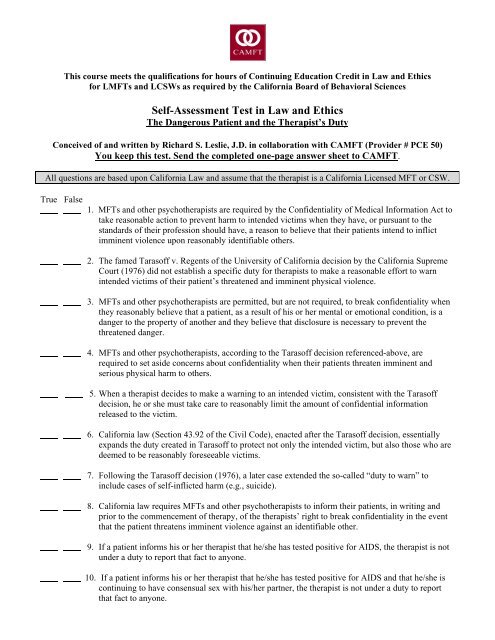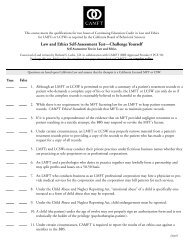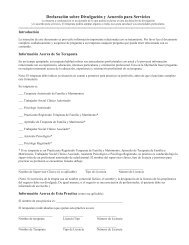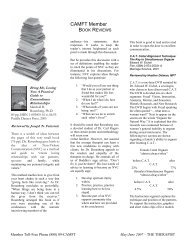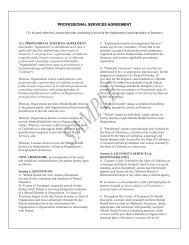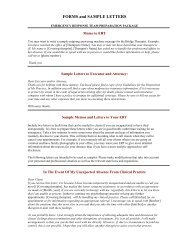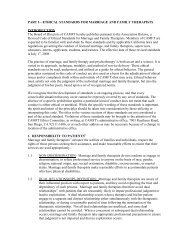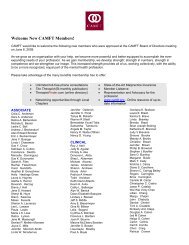Self-Assessment Test in Law and Ethics The Dangerous ... - CAMFT
Self-Assessment Test in Law and Ethics The Dangerous ... - CAMFT
Self-Assessment Test in Law and Ethics The Dangerous ... - CAMFT
Create successful ePaper yourself
Turn your PDF publications into a flip-book with our unique Google optimized e-Paper software.
This course meets the qualifications for hours of Cont<strong>in</strong>u<strong>in</strong>g Education Credit <strong>in</strong> <strong>Law</strong> <strong>and</strong> <strong>Ethics</strong><br />
for LMFTs <strong>and</strong> LCSWs as required by the California Board of Behavioral Sciences<br />
<strong>Self</strong>-<strong>Assessment</strong> <strong>Test</strong> <strong>in</strong> <strong>Law</strong> <strong>and</strong> <strong>Ethics</strong><br />
<strong>The</strong> <strong>Dangerous</strong> Patient <strong>and</strong> the <strong>The</strong>rapist’s Duty<br />
Conceived of <strong>and</strong> written by Richard S. Leslie, J.D. <strong>in</strong> collaboration with <strong>CAMFT</strong> (Provider # PCE 50)<br />
You keep this test. Send the completed one-page answer sheet to <strong>CAMFT</strong>.<br />
All questions are based upon California <strong>Law</strong> <strong>and</strong> assume that the therapist is a California Licensed MFT or CSW.<br />
True False<br />
1. MFTs <strong>and</strong> other psychotherapists are required by the Confidentiality of Medical Information Act to<br />
take reasonable action to prevent harm to <strong>in</strong>tended victims when they have, or pursuant to the<br />
st<strong>and</strong>ards of their profession should have, a reason to believe that their patients <strong>in</strong>tend to <strong>in</strong>flict<br />
imm<strong>in</strong>ent violence upon reasonably identifiable others.<br />
2. <strong>The</strong> famed Tarasoff v. Regents of the University of California decision by the California Supreme<br />
Court (1976) did not establish a specific duty for therapists to make a reasonable effort to warn<br />
<strong>in</strong>tended victims of their patient’s threatened <strong>and</strong> imm<strong>in</strong>ent physical violence.<br />
3. MFTs <strong>and</strong> other psychotherapists are permitted, but are not required, to break confidentiality when<br />
they reasonably believe that a patient, as a result of his or her mental or emotional condition, is a<br />
danger to the property of another <strong>and</strong> they believe that disclosure is necessary to prevent the<br />
threatened danger.<br />
4. MFTs <strong>and</strong> other psychotherapists, accord<strong>in</strong>g to the Tarasoff decision referenced-above, are<br />
required to set aside concerns about confidentiality when their patients threaten imm<strong>in</strong>ent <strong>and</strong><br />
serious physical harm to others.<br />
5. When a therapist decides to make a warn<strong>in</strong>g to an <strong>in</strong>tended victim, consistent with the Tarasoff<br />
decision, he or she must take care to reasonably limit the amount of confidential <strong>in</strong>formation<br />
released to the victim.<br />
6. California law (Section 43.92 of the Civil Code), enacted after the Tarasoff decision, essentially<br />
exp<strong>and</strong>s the duty created <strong>in</strong> Tarasoff to protect not only the <strong>in</strong>tended victim, but also those who are<br />
deemed to be reasonably foreseeable victims.<br />
7. Follow<strong>in</strong>g the Tarasoff decision (1976), a later case extended the so-called “duty to warn” to<br />
<strong>in</strong>clude cases of self-<strong>in</strong>flicted harm (e.g., suicide).<br />
8. California law requires MFTs <strong>and</strong> other psychotherapists to <strong>in</strong>form their patients, <strong>in</strong> writ<strong>in</strong>g <strong>and</strong><br />
prior to the commencement of therapy, of the therapists’ right to break confidentiality <strong>in</strong> the event<br />
that the patient threatens imm<strong>in</strong>ent violence aga<strong>in</strong>st an identifiable other.<br />
9. If a patient <strong>in</strong>forms his or her therapist that he/she has tested positive for AIDS, the therapist is not<br />
under a duty to report that fact to anyone.<br />
10. If a patient <strong>in</strong>forms his or her therapist that he/she has tested positive for AIDS <strong>and</strong> that he/she is<br />
cont<strong>in</strong>u<strong>in</strong>g to have consensual sex with his/her partner, the therapist is not under a duty to report<br />
that fact to anyone.
11. <strong>The</strong> Tarasoff decision relieved therapists of a duty to predict dangerousness, <strong>and</strong> only required the<br />
therapist to warn the <strong>in</strong>tended victim when the patient directly communicated a serious <strong>and</strong><br />
imm<strong>in</strong>ent threat to the psychotherapist.<br />
12. If a patient threatens a therapist with physical violence, the therapist is prohibited from <strong>in</strong>form<strong>in</strong>g<br />
the police <strong>and</strong> lett<strong>in</strong>g them know of the patient’s threat.<br />
13. A therapist is told by the patient that the patient had killed someone two years earlier. <strong>The</strong> therapist<br />
is not under a duty to disclose this <strong>in</strong>formation to anyone.<br />
14. A therapist is treat<strong>in</strong>g a police officer for depression. <strong>The</strong> therapist is told by the patient that he/she<br />
been th<strong>in</strong>k<strong>in</strong>g about committ<strong>in</strong>g suicide. <strong>The</strong> therapist must break confidentiality.<br />
15. If a patient communicates to his/her therapist a serious threat of imm<strong>in</strong>ent physical violence aga<strong>in</strong>st<br />
a readily identifiable other, the therapist can ga<strong>in</strong> immunity from liability by mak<strong>in</strong>g a reasonable<br />
effort to warn the victim or by arrang<strong>in</strong>g for the hospitalization of the patient.<br />
16. If a patient communicates to his/her therapist a serious threat of imm<strong>in</strong>ent physical violence aga<strong>in</strong>st<br />
a readily identifiable other, the therapist is permitted to <strong>in</strong>voluntarily hospitalize the patient <strong>and</strong> is<br />
not required to notify the police.<br />
17. Section 43.92 of the Civil Code was enacted after the Tarasoff decision <strong>and</strong> was <strong>in</strong>tended to codify<br />
the duty created <strong>in</strong> the Tarasoff decision.<br />
18. Because of Section 43.92 of the Civil Code, therapists are no longer required to take reasonable<br />
steps to protect an <strong>in</strong>tended victim unless the serious threat of imm<strong>in</strong>ent physical violence is<br />
directly communicated from the patient to the therapist.<br />
19. When a therapist determ<strong>in</strong>es that his or her patient presents a serious <strong>and</strong> imm<strong>in</strong>ent danger of<br />
physical violence to another, the therapist is permitted, but not required, to take reasonable steps to<br />
protect the <strong>in</strong>tended victim, such as warn<strong>in</strong>g the <strong>in</strong>tended victim, notify<strong>in</strong>g law enforcement, or<br />
tak<strong>in</strong>g such other steps as may be necessary to avert the danger.<br />
20. In order for the Tarasoff duty to apply, the victim must be specifically named by the patient or by a<br />
family member.<br />
21. If a patient tells his therapist that his (the patient’s) wife told him that she is go<strong>in</strong>g to kill the<br />
patient’s lover, the therapist is required to take reasonable steps to prevent the threatened violence.<br />
22. If a patient threatens violence, but does not reveal the identity of the victim, the therapist is<br />
permitted to take reasonable steps to prevent the threatened danger even if it <strong>in</strong>volves break<strong>in</strong>g the<br />
patient’s confidentiality.<br />
23. If a therapist fails to comply with his/her duty to protect an <strong>in</strong>tended victim aga<strong>in</strong>st the threats of<br />
the patient, he/she can have liability not only to the <strong>in</strong>tended victim, but to reasonably foreseeable<br />
others who may be <strong>in</strong>jured at the time the violence is perpetrated.<br />
24. <strong>The</strong>rapists are generally duty bound to warn not only the <strong>in</strong>tended victim, but others who are<br />
deemed to be reasonably foreseeable victims.<br />
25. When a therapist makes a warn<strong>in</strong>g to the <strong>in</strong>tended victim pursuant to his/her duty under either the<br />
Tarasoff decision or Section 43.92 of the Civil Code, he/she is permitted to let the victim know<br />
his/her name, that he/she is treat<strong>in</strong>g the patient as a mental health practitioner, <strong>and</strong> that he/she<br />
believes that the patient’s threat is serious <strong>and</strong> that the danger is imm<strong>in</strong>ent.<br />
NOTICE<br />
Copyright law prohibits the copy<strong>in</strong>g, reproduction or transmission <strong>in</strong> any form or by any means, whether mechanical,<br />
photographic or electronic, of any portion of this self-assessment test or the answer sheet that will be mailed to participants,<br />
without the express written permission of Richard S. Leslie. All rights reserved.<br />
© Richard S. Leslie, 2005
RECEIVE TWO HOURS OF CONTINUING EDUCATION CREDIT BY SELF-STUDY<br />
<strong>Self</strong>-<strong>Assessment</strong> <strong>Test</strong> <strong>in</strong> <strong>Law</strong> <strong>and</strong> <strong>Ethics</strong><br />
<strong>The</strong> <strong>Dangerous</strong> Patient <strong>and</strong> the <strong>The</strong>rapist’s Duty<br />
Conceived of <strong>and</strong> Written by Richard S. Leslie, J.D., <strong>in</strong> collaboration with <strong>CAMFT</strong><br />
BBS Approved Provider # PCE 50<br />
A. Answer True or False (T or F)<br />
COMPLETE ANSWER SHEET – SEND CHECK<br />
1 6 11 16 21<br />
2 7 12 17 22<br />
3 8 13 18 23<br />
4 9 14 19 24<br />
5 10 15 20 25<br />
B. Please provide the follow<strong>in</strong>g <strong>in</strong>formation: (Please Pr<strong>in</strong>t)<br />
Name<br />
<strong>CAMFT</strong> Member # License #<br />
Additional License / Certification #<br />
Mail<strong>in</strong>g Address<br />
Telephone Number ( ) Fax Number ( )<br />
E-mail Address<br />
C. Send this completed answer sheet to <strong>CAMFT</strong> with a check for $35 made payable to <strong>CAMFT</strong>. YOU<br />
KEEP THE TEST.<br />
We will send you verification of course completion, an evaluation form, <strong>and</strong> the answers.<br />
California Association of Marriage <strong>and</strong> Family <strong>The</strong>rapists<br />
7901 Raytheon Road<br />
San Diego, CA 92111-1606<br />
Phone (888) 892-2638 · Fax (858) 292-2666


